


The drama at the Roman Theatre was the most popular show
in town that season. It was called Gunplay and was filled with the violence
and action and noises of gang warfare - a bit raw, a bit nasty and obviously
pleasing to the audience. Shortly after the curtain rose on Act II, there
was a slight commotion in the theatre. At first only a few noticed. Then
there was a scream and the lights snapped on. Near a closed exit, a large
policeman stood holding a slight, nervous man by the arm."Don't get out of
your seat, any of you!" The audience laughed, thinking it was part of the
play. But when a squad of bluecoats, headed by a tall man in plain clothes,
marched down the aisle, pandemonium broke out. "What's up, Doyle?" Suit, cape and gloves
worn with a whisky flair...everything but the top hat. And he was dead. With
a characteristic display of intemperance, Monte Field had succumbed during
the Act II of the Broadway hit 'Gunplay'. |
| "Gets our
class A rating." -- H.V. O'Brien, Chicago Daily News "Murder in the theatre... a knockout ... three hours of breathless bliss." -- Detroit Free Press "Not only is his story really exciting but he himself plays absolutely fair - a fact which you may discover for yourself if, as you will probably want to do, you turn back after reading the last page and skim through the book again ... a worthy successor to Holmes... At the end too, a delectable 'surprise' is not lacking. The whole thing is most admirably done - the detective story de luxe." -- Ralph Straus, Sunday Times |
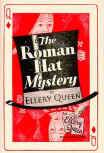 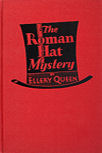   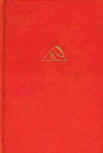 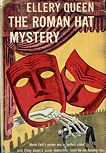 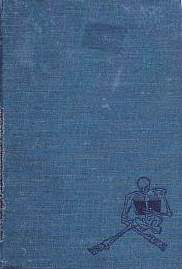 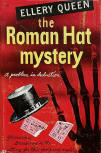 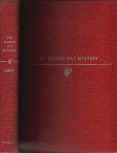 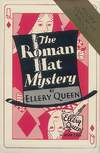  |
| Above: The first books published sometimes had identical front covers. The spine of the books/dust cover only differ in the publisher's logo. Top left to bottom right: both dust cover and hardcover for Stokes, Grosset & Dunlap respectively ending with International Readers League (hardcover only), dust and hardcover Triangle Books; dust and hardcover for the Tower/ World Publishing edition ending with the dust and hardcover for the Mysterious Press' 50th birthday (Golden Anniversary) edition which had a new introduction by Frederic Dannay. (Click on the covers to see the differences) * |
| Buffalo Evening News, "Through the Hat" -
August 24, 1929 Offering as clever a problem in deductions as one may find in a year of browsing through mysterio-detective literature, Ellery Queen in his novel, "The Roman Hat Mystery." deftly twists the readers around his finger. This story is one of pure analysis, an entirely new mode in a popular type of fiction. Disregarding the statement of the publisher that "The Roman Hat Mystery" is so outstanding in merit that the house of Stokes will publish no other detective novel this season, and appraising it in the cold light of skepticism, if not mistrust, we are compelled to admit that here is something of paramount importance in the field of literary endeavor where many have trod with more than average success. From the first to the last line Ellery Queen presents a novel that radically differs from the plethora of thrillers. The plot is of fascinating complexity, the setting romantic, the style wholly pleasing and the deductive pattern most ingenious in weave. Ellery Queen's characterization Is superb. One feels that he knows intimately each one of the clearly-cut personages who figure in the solving of the hat mystery. The story concerns a top hat, which at first seems an inconsequential clue, but about this elusive thread is spun the entire amazing yarn. Amid the roar of stage gun fire in the Roman theater in New York the agonized whispers of Monte Field, a lawyer with a wide range of criminal associations, reveal a murder while the audience is engrossed In "Gun Play." The only clue to the murderer of Field is his missing top hat. But why the hat? It seems that Field, a blackmailer on a large scale, doted on using a top hat as the repository for papers which pried dollars from his victims. It also Is known that Field lettered the name of the victim on the band of the hat, so if once the hat is in hand so also is the name of the murderer. The hat then loads the likeable, elderly, snuff-taking Inspector Richard Queen, through a labyrinth of interesting, and at times, contradictory situations. There are no spectacular scenes, no succession of murders, no rushing of detectives hither and yon at breakneck speed, no hocus pocus and no resort to the hackneyed formula of mystery tales. Instead, there Is a deep study of the case which is analyzed with remarkable psychological technique. The reader is given, every fact necessary to the solution of the case, but his is kept baffled to the startling denouement. |
| The debut novel of the legendary Ellery Queen,
The Roman Hat Mystery (1929), holds a unique place in the annals of
detective literature. Crafted by cousins Frederic Dannay and Manfred B. Lee,
who jointly adopted the pseudonym Ellery Queen, this book
marks the inception of their enduring partnership and the beginning of an
iconic series of mysteries. The origins of The Roman Hat Mystery trace back to a fortuitous lunch in an Italian restaurant in 1928. Dannay and Lee stumbled upon a $7,500 detective story contest co-sponsored by McClure's Magazine and Lippincott's publishing house (Frederick A. Stokes Company). The cousins, inspired by the substantial prize—$5,000 for serial rights and $2,500 for hardcover rights—decided on the spot to enter the competition. This decision not only birthed their first novel but also introduced the world to Ellery Queen, their fictional sleuth. The admiration Frederic Dannay had for Maurice Leblanc's Arsene Lupin surfaces and the more I look into this, the more I tend to believe that Ellery always has been more of a new Lupin than a new  Sherlock Holmes as some covers tend
to suggest. Michael
E.Grost added some other interesting observations: "Rufus
King's first Lt. Valcour novel, Murder by the Clock, had a
simple plot idea involving men's hats. It was apparently serialized in
magazines in 1928, before its book publication in 1929. It is possible that
EQ used King's work as a jumping off point and subsequent works. One wonders
if the name "Rufus King" affected EQ's choice of the pseudonym
Ellery Queen." Sherlock Holmes as some covers tend
to suggest. Michael
E.Grost added some other interesting observations: "Rufus
King's first Lt. Valcour novel, Murder by the Clock, had a
simple plot idea involving men's hats. It was apparently serialized in
magazines in 1928, before its book publication in 1929. It is possible that
EQ used King's work as a jumping off point and subsequent works. One wonders
if the name "Rufus King" affected EQ's choice of the pseudonym
Ellery Queen."However the influence of S.S. Van Dine, creator of the popular detective Philo Vance, is so evident in The Roman Hat Mystery. Van Dine’s style—intellectual, logical, and deductive—captivated Dannay and Lee, who admired his commercial success and intricate plotting. Like Philo Vance, Ellery Queen is a highly intellectual detective with a penchant for literary references. Both characters operate in elite social circles, gaining access to investigations through personal connections. The supporting characters in Queen’s debut, such as Sergeant Velie and Doc Prouty, mirror their counterparts in Van Dine’s novels, establishing a template for future Ellery Queen stories. Dannay recalled, "...Van Dine influenced us because he made so much money; and then, the kind of thing he did appealed to us in those days. It was complex, logical, deductive, almost entirely intellectual..." (Nevins). |
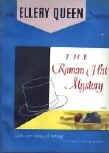  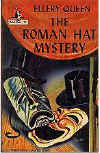      |
|
Set against the backdrop of the bustling Roman Theatre in New York, the plot
revolves around the murder of Monte Field, a disreputable lawyer and
blackmailer. Field is discovered dead during the second act of the Broadway
hit Gunplay, a show epitomizing the gritty allure of gang warfare. The only
clue to the crime is the inexplicable absence of Field’s top hat—a seemingly
trivial item that holds the key to unraveling the mystery. Field’s top hat, it turns out, served as a repository for incriminating documents used in his blackmail schemes. The murderer’s motive centers on the hat and its contents, leading Inspector Richard Queen and his son, Ellery, through a labyrinth of suspects and motives. The narrative is marked by meticulous deductions, culminating in a surprising yet logical conclusion. The ingenious focus on a missing hat as the central clue showcases the authors’ originality and attention to detail. Its early chapters contain the first of the exhaustive searches so prominent in the Queen saga; its finale is of the deductive type, like most of the great Queen works; the deductions include a sequence investigating a large cast of characters, explaining why one and only one could have the properties of the guilty party, similar to later passages in The Dutch Shoe Mystery, Halfway House, and above all The Tragedy of Z. The chief plot idea in the solution is one that will pop up in variations throughout his 1930's works: e.g. The Spanish Cape Mystery. (Michael E.Grost) Upon its release, The Roman Hat Mystery garnered widespread acclaim for its complexity and ingenuity. Critics praised its adherence to the "fair play" principle, where all clues necessary to solve the mystery are presented to the reader. The Chicago Daily News lauded it as a "class A" mystery, while the Detroit Free Press called it "three hours of breathless bliss." The Sunday Times noted its "admirable"  construction,
comparing it favorably to the works of Sherlock Holmes. construction,
comparing it favorably to the works of Sherlock Holmes. |

|
The Roman Hat
Mystery Translations: |
|
Other articles on this book (1) The Green Capsule Noah Stewart (Jun 2017) (2) Mysteries Ahoy! Aiden Brack (Nov 2017) (3) Reading Ellery Queen Jon Mathewson (Feb 2013) (4) In which the Queens go the theatre Ho-Ling (May 10. 2013) (5) The Grandest Game in the World Nick Fuller (Aug 2021) (6) Dead Yesterday (April 2019) (7) The Invisible Event - The Underwhelming Origins of Ellery Queen in The Roman Hat Mystery JJ (June 2016) (8) In Search of the Classic Mystery Novel Puzzle Doctor (May 15. 2011) (9) Davy Crocketts' Almanac Evan Lewis (Mar 1. 2013) (10) AQ's Reviews (November 12. 2014) (11) Alligators and aneurysms! (July 29. 2023) James Weber (12) The Roman Hat Mystery Standard EBooks |
|
*
Interested readers should know
that the icons/covers
of books, used throughout the
website have extra
descriptions/information not
included in the text on the same
page. Pointing your cursor at
the icon/cover used to reveal
this extra information. To achieve the same effect Firefox users can install an add-on called 'Popup ALT Attribute'. When installed pointing your cursor at an icon/cover results in showing you the details or additional information. |
|
Page first published April 18. 1999 Version x2.1 - Last updated October 18. 2025 |

|